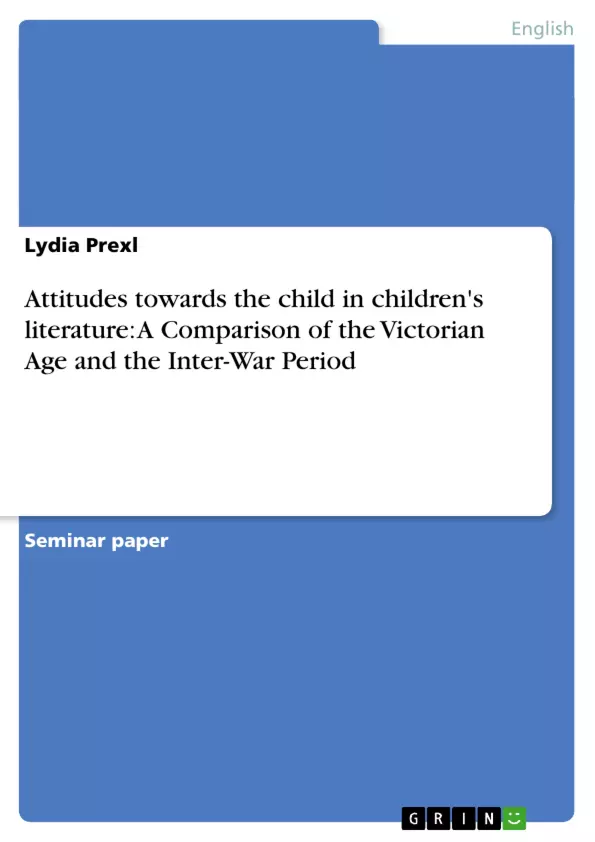Prior to the eighteenth and nineteenth century, childhood was not considered a separate stage of development. People at that time rather thought of children as miniature adults without a legal status. Due to new upcoming theories of philosophers such as John Locke or Jean-Jacques Rousseau however, children were seen in a new light. Thus, from the late eighteenth century onwards, parents slowly began to look at their children as individuals with concerns, wishes and fears much different from the adult. This new perception of childhood initiated authors to write literature both for and about children, which ultimately led to a new literal genre that we nowadays take for granted: children's literature.
The following essay will compare the attitudes towards the child in children's literature of the Victorian Age with the attitude portrayed in inter-war children's literature. It will explore how the perception of the child in the nineteenth century changed, how this change is reflected in the fiction of the time and how it affected the children's literature of the inter-war period. It will argue that whereas early children's literature was mostly didactic and addressing the adult rather than the child reader, novels of the middle and late nineteenth century concentrated more on young readers and their specific needs and desires by introducing a more entertaining and fabulous style of writing. The essay will then take a closer look at children's literature of the early twentieth century and demonstrate that fiction of that period continued to put the child in the focus of attention while at the same time dealing with new topics and offering ways of escapism with respect to the threat of the Second World War.
Inhaltsverzeichnis (Table of Contents)
- Attitudes towards the child in children's literature
- The Victorian Age
- The Evangelical School of Thought
- John Locke's Educational Philosophy
- The Romanticist Movement and Fairy Tales
- The Inter-War Period
Zielsetzung und Themenschwerpunkte (Objectives and Key Themes)
This essay compares attitudes towards children in children's literature of the Victorian Age and the Inter-War period, exploring how these perceptions evolved and their impact on the development of children's literature. It investigates how early children's literature focused on moral instruction, while later works transitioned toward a more entertaining and child-centered approach. Finally, the essay examines the role of escapism and new themes in children's literature during the Inter-War period.
- The evolving perception of childhood as a distinct stage of development.
- The influence of philosophical and educational theories on children's literature.
- The shift from didacticism to entertainment in children's literature.
- The role of fantasy, escapism, and new themes in children's literature.
- The influence of historical events, such as the threat of war, on children's literature.
Zusammenfassung der Kapitel (Chapter Summaries)
The essay begins by tracing the origins of children's literature to the late 18th century, emphasizing the emerging recognition of childhood as a separate stage of development. The Victorian Age is then explored through the lens of two dominant influences: the Evangelical School of Thought, which emphasized moral instruction and discipline, and John Locke's educational philosophy, which advocated for shaping the child's mind through education. This section examines prominent examples, such as Mary Martha Sherwood's "The History of the Fairchild Family," illustrating the prevalent didactic approach and emphasis on moral behavior in early Victorian children's literature.
The essay then explores the influence of the Romanticist movement on Victorian children's literature. This section highlights the shift towards a more child-centered approach, incorporating fantasy, nature, and emotion as key elements. Examples like Charles Dickens' "David Copperfield" and Charles Kingsley's "Water Babies" are cited to illustrate this transition. The essay concludes this section by discussing the acceptance of fairy tales and fantastical elements, previously viewed with suspicion, as a result of the Romanticist influence and its emphasis on childhood innocence and imagination.
Schlüsselwörter (Keywords)
This essay focuses on children's literature, attitudes towards children, didacticism, entertainment, Victorian Age, Inter-War period, Evangelical School of Thought, John Locke, Romanticism, fantasy, escapism, childhood innocence, and moral instruction.
- Quote paper
- Lydia Prexl (Author), 2008, Attitudes towards the child in children's literature: A Comparison of the Victorian Age and the Inter-War Period, Munich, GRIN Verlag, https://www.grin.com/document/128323



